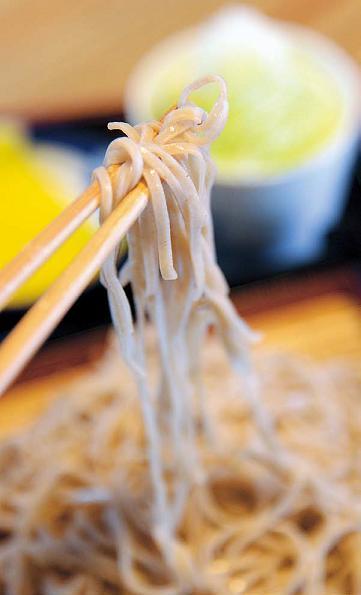Subaru owner-chef Kang Young-chul changed the course of his career for soba ― those storied buckwheat noodles that were once standard fare for laborers in 17th-century Edo.
While working in Japan, Kang grew interested in the traditional noodles, a staple of the Tokyo diet, and decided to learn how to make them himself.
He enrolled in a course in Asakusa, Tokyo, and made the transition from office worker to chef.
 |
Subaru owner-chef Kang Young-chul crafts his delicate and chewy soba from freshly milled buckwheat. (Ahn Hoon/The Korea Herald) |
After mastering the art of handmade soba, Kang opened his restaurant in Hongdae in 2001. Two years later, an opportunity arose to return to his old profession and work abroad in Nagoya, Japan. Kang closed shop and went back to Japan.
Then, four years ago, he returned to his home turf and reopened Subaru, this time in Bangbae-dong in southern Seoul. He has not looked back since.
“Buckwheat is good for your health,” the 54-year-old chef expanded upon the charms of soba. “I know because I ate it every day.”
A staunch devotee of traditional Japanese soba, Kang makes buckwheat noodles up to eight times a day, kneading dough in a huge red lacquered bowl, then rolling, folding and cutting the dough until long, thin, delicate strands of noodles emerge.
Passersby can see Kang in action through the large front window of the restaurant where his noodle-crafting station is. The set-up is reminiscent of venerable soba restaurants in Asakusa, where temple-goers can witness heirs to the craft at work.
Determined to preserve as much of the aroma of buckwheat as possible, Kang also mills whole buckwheat in his restaurant.
In true Tokyo fashion, Kang mixes eight parts buckwheat to two parts flour for chewy, glossy brown noodles that are slightly sweet and, of course, incredibly nutty.
The resulting soba is chewy and fragrant.
If ordered as zaru soba, where the noodles are served unadorned, with a dipping sauce, Kang recommends tasting one to two strands first, allowing one to fully enjoy the elasticity, the clean sweetness and smooth silkiness of the noodles.
Then Kang suggests dunking the tips of one’s chopsticks in the dipping sauce and tasting before adding wasabi, grated daikon radish and green onion.
After adding ingredients to the sauce, Kang says one should only dip noodles one-third of the way in, so the sauce does not overpower the aromas of buckwheat.
Warm water in which the buckwheat noodles have been boiled is served in a red teapot, so that when one is done dipping and slurping the soba, one can pour the soba water into the remaining sauce and drink.
While zaru soba is a great way to enjoy Kang’s expertly crafted noodles, those who want something different can select from 12 different kinds of soba, including a popular warm soba dish called tamago toji.
Buckwheat noodles are served up in an egg-flecked broth. Lemon peel adds a pleasant citrus aroma to the heart-warming dish.
Details
Subaru (02) 596-4882
18-23 Bangbae-dong, Seocho-gu, Seoul
Open 11:30 a.m. to 2:30 p.m., 5:30 p.m. to 8:30 p.m. daily. Closed Mondays
soba costs 10,000 won to 16,000 won
By Jean Oh (
oh_jean@heraldcorp.com)





![[Exclusive] Hyundai Mobis eyes closer ties with BYD](http://res.heraldm.com/phpwas/restmb_idxmake.php?idx=644&simg=/content/image/2024/11/25/20241125050044_0.jpg)
![[Herald Review] 'Gangnam B-Side' combines social realism with masterful suspense, performance](http://res.heraldm.com/phpwas/restmb_idxmake.php?idx=644&simg=/content/image/2024/11/25/20241125050072_0.jpg)

